- Home
- John Berger
Bento's Sketchbook Page 3
Bento's Sketchbook Read online
Page 3
(Ethics, Part II, Proposition XV, Proof)
Around her is a block. The block is invisible because it’s totally transparent. Nor does the block restrict her movements. Is the block what separates Being from Becoming? I don’t know, for this is happening where there are no words.
Normally, we face words frontally and so can read them, speak them or think them. This was happening somewhere to the side of language. Any frontal view of language was impossible there. From the side I could see how language was paper thin, and all its words were foreshortened to become a single vertical stroke – I – like a single post in a vast landscape.
The task was to dismantle the block – to take it apart and lift it off piece by piece. She allowed this to happen – No. Active and Passive have merged together. Let us say: She happened this to herself with the utmost ease. I was with her in what she (we) were doing.
We began with her head and worked downwards towards the feet. When freed of the block, the part of her body disclosed did not change in appearance. Yet it changed. It disarmed all comment. It precluded any response except that of acceptance. Or, to put it another way: faster than any possible response, the part of her body which was disclosed, claimed its own acceptance.
Although everything was done with ease, the task was tiring, at least for me. Between the removal of each portion of the block, I returned to my own body in my own bed, glad to take a rest for a moment, until the next removal, or the next part of the dream. Was the act of dreaming synonymous with the act of dismantling the block?
I knew all the answers then. Where there are no words, knowledge comes through physical acts and through the space through which those acts are made; by permitting each act the space conferred meaning upon it and no further meaning was necessary.
Each time I felt tired I embraced her.
I don’t know how many pieces the block was divided into. The task took all night.
One thing I do remember: each new part of her body disclosed by the removal of another piece of the block was equal to the preceding one. Not necessarily equal in size but in significance.
Writing now I suspect the sequence these words suggest is too simple: first head, then shoulders, then belly, then feet. We did not proceed like this.
The word dismantle which I have used, aware of its apparent inappropriateness, may help us here. A block or a cast enclosing another form is not usually dismantled but rather ‘broken away’ or ‘split open’. This block, however, had not been made in one go, and so it could not be opened in one go. It had to be taken to pieces, and the pieces did not always correspond in size, in area, to the newly disclosed part of her body. Perhaps each piece of the block was unwound like a cloth from her whole body? All I know is that the process proceeded by stages and that each stage meant there was less block left. Eventually there was none.
She was there whole, looking exactly as she had at the beginning, capable of the same actions and no more, having the same name, the same habits, the same history. Yet, freed from the block, the relations between her and everything which was not her had changed. An absolute yet invisible change. She was now the centre of what surrounded her. All that was not her made space for her.
The centre of the city of Dresden was still razed to the ground when I first met Erhard Frommhold there in the early 1950s. The Allied bombing of the city on February 13, 1945, had killed in a single night 100,000 civilians; most of them burnt to death in temperatures that reached 1800° Fahrenheit. In the 1950s Frommhold was working as an editor in the VEB Verlag der Kunst.
He was my first publisher. He published a book about the Italian painter Renato Guttuso, several years before any book of mine was published in Britain. Thanks to him I discovered that, despite my doubts, I was capable of finishing a book.
Erhard was lithe and had the physical presence of an athlete or football player. Perhaps more accurately the latter, for he came from a working-class family. His energy was striking, concentrated and reticent – somewhat like the pulse at the pit of his neck.
Both his lean energy and the devastation of the city testified, at that time, to the force of history. It was history then, not brand-names, that began with a capital letter. What History signified or promised, however, was open to various interpretations. Was it better or not to let some of the sleeping dogs lie?
Erhard was two years younger than I, but I thought of him in Dresden as being several years my senior. He was more experienced, he had lived more History. He was a kind of elected elder brother. Today, when the principles of Fraternity and Equality have been declared obsolete by every Bad Government in the world, this may sound sentimental, but it wasn’t.
We were not intimate as natural brothers sometimes are. What was fraternal between us was a certain trust: an existential trust which ultimately derived from a marxist reading of history. Reading or perspective? I would say perspective, for what was essential was another sense of time, which could accommodate both the long term (centuries) and the urgent (half past two tomorrow afternoon).
We seldom talked in detail about politics – in part because we didn’t have a fluent common language, but also because both of us were covertly nonconformist and opposed to simplifications. Both of us listened hard to Bertolt Brecht, who was our elected uncle.
One of Brecht’s Herr K stories is about Socrates. Socrates is listening to some Sophist philosophers endlessly pontificating, and so finally he steps forward and states: All I know is that I know nothing! This sentence is greeted with deafening applause. And Herr K wonders whether Socrates had something to add, or whether the applause had rendered what followed inaudible for the next two thousand years!
When we heard this, we smiled and glanced at one another. And somewhere behind our agreement was the tacit recognition that any original political initiative has to start off as being clandestine, not through a love of secrecy, but because of the innate paranoia of the politically powerful.
Everyone in the DDR was aware of history, its bequests, its indifference, its contradictions. Some resented it, some tried to use it to their own advantage, most concentrated on surviving beside it and a few – a very few – tried to live with dignity whilst facing it night and day. And Erhard was among those few. This is why he was an example for me, a hero, who had a deep effect on what I wanted to try to become.
His example wasn’t an intellectual but an ethical one. It was given to me by my observing and trying to respond to his daily behaviour, the precise way he encountered events and people.
Can I define it? I never formulated it for myself; it was an almost wordless example, like the quality of a particular silence.
He gave me a touchstone for distinguishing between the false and the genuine, between – in Spinoza’s terms – the inadequate and the adequate.
Touchstones, however, indicate by way of a mineral reaction, not through a discursive debate. The original touchstone was a flint reacting to silver and gold.
Writing, this, I think of the etching by Käthe Kollwitz entitled Working-Class Woman (with earring) 1910.
Erhard and I both admired Kollwitz. Just as History was indifferent, she was caring. Yet her horizon was no narrower. Hence the pain she shared.
Erhard looked unflinchingly at History. He measured the catastrophes of the past and their scale, and accordingly he chose proposals for a future of greater justice and more compassion, whilst never forgetting that the pursuit of those proposals was likely to involve threats, accusations and ceaseless struggle, for History, even when recognised, is eternally recalcitrant.
In the ’70s, Erhard was sacked from the Verlag der Kunst, of which he was by then director, and was accused, on account of several of the books he had edited, of formalism, bourgeois decadence and factionalism. Fortunately he was not jailed. He was simply condemned to performing socially useful work: as a gardener’s assistant in a public park.
Look again at the etching by Kollwitz. The earring is a small but proud declaration of hope, yet
it is totally outshone by the light of the face, which is inseparable from its nobility. Meanwhile the face has been drawn with black lines from the surrounding blackness. And this perhaps is why she chose to wear earrings!
Erhard’s example offered a small, undemonstrative, persistent hope. It embodied endurance. An endurance that was not passive but active, an endurance that was the result of the taking on of History, an endurance that guaranteed a continuity despite History’s recalcitrance.
A sense of belonging to what-has-been and to the yet-to-come is what distinguishes man from other animals. Yet to face History is to face the tragic. Which is why many prefer to look away. To decide to engage oneself in History requires, even when the decision is a desperate one, hope. An earring of hope.
All actions which follow from the emotions which are related to the mind, in so far as it understands, I refer to fortitude, which I distinguish into courage and generosity. For I understand by courage the desire by which each endeavours to preserve what is his own according to the dictate of reason alone. But by generosity I understand the desire by which each endeavours according to the dictate of reason alone to help and join to himself in friendship all other men. And so I refer those actions which aim at the advantage of the agent alone to courage, and those which aim at the advantage of others to generosity. Therefore temperance, sobriety, and presence of mind in danger, etc., are species of courage; but modesty, clemency, etc., are species of generosity. And thus I think I have explained and shown through their primary causes the principal emotions and waverings of the mind which arise from the composition of the three primary emotions, namely, pleasure, pain and desire. And it is apparent from these propositions that we are driven about by external causes in many manners, and that we, like waves of the sea driven by contrary winds, waver, unaware of the issue and of our fate.
(Ethics, Part III, Proposition LIX, Note)
By body (corpus) I understand a mode which expresses in a certain and determinate manner the essence of God, in so far as he is considered as an extended thing.
(Ethics, Part II, Definition I)
I was in London on Good Friday, 2008. And I decided, early in the morning, to go to the National Gallery and look at the Crucifixion by Antonello da Messina. It’s the most solitary painting of the scene that I know. The least allegorical.
In Antonello’s work – and there are less than forty paintings which are indisputably his – there’s a special Sicilian sense of thereness which is without measure, which refuses moderation or self-protection. You can hear the same thing in these words spoken by a fisherman from the coast near Palermo, and recorded by Danilo Dolci a few decades ago.
‘There’s times I see the stars at night, especially when we’re out for eels, and I get thinking in my brain, “The world, is it really real?” Me, I can’t believe that. If I get calm, I can believe in Jesus. Bad-mouth Jesus Christ and I’ll kill you. But there’s times I won’t believe, not even in God. “If God really exists, why doesn’t He give me a break and a job?” ’
In a Pietà painted by Antonello – it’s now in the Prado – the dead Christ is held by one helpless angel who rests his head against Christ’s head. The most piteous angel in painting.
Sicily, island which admits passion and refuses illusions.
I took the bus to Trafalgar Square. I don’t know how many hundred times I’ve climbed the steps from the square that lead up to the Gallery and to a view, before you enter, of the fountains seen from above. The Square, unlike many notorious city assembly points – such as the Bastille in Paris – is, despite its name, oddly indifferent to history. Neither memories nor hopes leave a trace there.
In 1942 I climbed the steps to go to piano recitals given in the Gallery by Myra Hess. Most of the paintings had been evacuated because of the air-raids. She played Bach. The concerts were at midday. Listening, we were as silent as the few paintings on the walls. The piano notes and chords seemed to us like a bouquet of flowers held together by a wire of death. We took in the vivid bouquet and ignored the wire.
It was the same year, 1942, that Londoners first heard on the radio – in the summer, I think – Shostakovich’s 7th Symphony, dedicated to besieged Leningrad. He had begun composing it in the city during the siege in 1941. For some of us the symphony was a prophecy. Hearing it, we told ourselves that the resistance of Leningrad, now being followed by that of Stalingrad, would finally lead to the Wehrmacht’s defeat by the Red Army. And this is what happened.
Strange how in wartime music is one of the very few things which seem indestructible.
I find the Antonello Crucifixion easily, hung at eye-level, left of the entry to the room. What is so striking about the heads and bodies he painted is not simply their solidity, but the way the surrounding painted space exerts a pressure on them and the way they then resist this pressure. It is this resistance which makes them so undeniably and physically present. After looking for a long while, I decide to try to draw only the figure of Christ.
A little to the right of the painting, near the entry, there is a chair. Every exhibition room has one and they are for the official gallery attendants, who keep an eye on the visitors, warn them if they go too close to a painting, and answer questions.
As an impecunious student I used to wonder how the attendants were recruited. Could I apply? No. They were elderly. Some women but more men. Was it a job offered to certain city employees before retirement? Did they volunteer? Anyway, they come to know some paintings like their own back gardens. I overheard conversations like this:
Can you tell us please where the works by Velázquez are?
Yes, yes. Spanish School. In Room XXXII. Straight on, turn right at the end then take the second on your left.
We’re looking for his portrait of a stag.
A stag? That’s to say a male deer?
Yes, only his head.
We have two portraits of Philip the Fourth – and in one of them his magnificent moustache curls upwards, like antlers do. But no stag, I’m afraid.
How odd!
Perhaps your stag is in Madrid. What you shouldn’t miss here is Christ in the house of Martha. Martha’s preparing a sauce for some fish, pounding garlic with a pestle and mortar.
We were in the Prado but there was no stag there. What a pity!
And don’t miss our Rokeby Venus. The back of her left knee is something.
The attendants always have two or three rooms to survey and so they wander from one room to another. The chair beside the Crucifixion is for the moment empty. After taking out my sketchbook, a pen and a handkerchief, I carefully place my small shoulder bag on the chair.
I start drawing. Correcting error after error. Some trivial. Some not. The crucial question is the scale of the cross on the page. If this is not right, the surrounding space will exert no pressure, and there’ll be no resistance. I’m drawing with ink and wetting my index finger with spit. Bad beginning. I turn the page and restart.
I won’t make the same mistake again. I’ll make others, of course. I draw, correct, draw.
Antonello painted, in all, four Crucifixions. The scene he returned to most, however, was that of Ecce Homo, where Christ, released by Pontius Pilate, is put on display, mocked, and hears the Jewish high priests calling for his Crucifixion.
He painted six versions. All of them close-up portraits of Christ’s head, solid in suffering. Both the face and painting of the face are unflinching. The same lucid Sicilian tradition of taking the measure of things – without either sentimentality or flattery.
Does the bag on the chair belong to you?
I glance sideways. An armed security guard is scowling and pointing at the chair.
Yes, it’s mine.
It’s not your chair!
I know. I put my bag there because nobody was sitting on it. I’ll remove it straightaway.
I pick up the bag, take one step left to the painting, place the bag between my feet on the floor, and re-look at my drawing.
&nb
sp; That bag of yours cannot stay on the floor.
You can search it – here’s my wallet and here are things to draw with, nothing else.
I hold the bag open. He turns his back.
I put the bag down and start drawing again. The body on the cross for all its solidity is so thin. Thinner than one can imagine before drawing it.
I’m warning you. That bag cannot stay on the floor.
I’ve come to draw this painting because it’s Good Friday.
It’s forbidden.
I continue drawing.
If you persist, the security guard says, I’ll call the Super.
I hold the drawing up so he can see it.
He’s in his forties. Stocky. With small eyes. Or eyes that he makes small with his head thrust forward.
Ten minutes, I say, and I’ll have finished it.
I’m calling the Super now, he says.
Listen, I reply, if we have to call, let’s call somebody from the Gallery staff and with a bit of luck they’ll explain that it’s OK.
Gallery staff have nothing to do with us, he grunts, we’re independent and our job is security.
Security my arse! But I don’t say it.
He starts to pace slowly up and down like a sentry. I draw. I’m drawing the feet now.
I count to six, he says, then I call.
He’s holding his cell phone to his mouth.
One!
I’m licking my finger to make grey.
Two!
I smudge the ink on the paper with my finger to mark the dark hollow of one hand.
Three!
The other hand.
Four! He strides towards me.
Five! Put your bag on your shoulder.
I explain to him that, given the size of the sketch pad, if I do this, I can’t draw.
Bag on your shoulder!
He picks it up and holds it in front of my face.

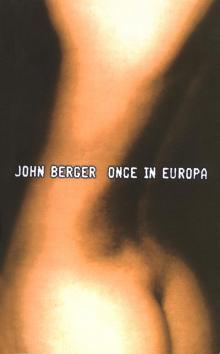 Once in Europa
Once in Europa To the Wedding
To the Wedding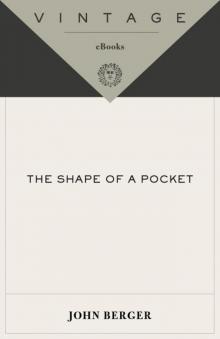 The Shape of a Pocket
The Shape of a Pocket Here Is Where We Meet
Here Is Where We Meet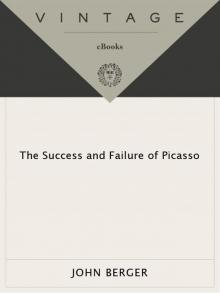 The Success and Failure of Picasso
The Success and Failure of Picasso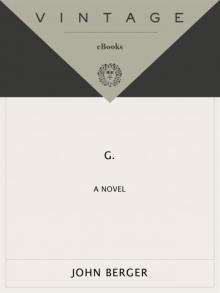 G.
G. Photocopies: Encounters
Photocopies: Encounters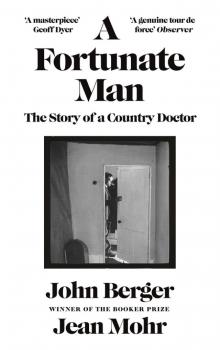 A Fortunate Man: The Story of a Country Doctor
A Fortunate Man: The Story of a Country Doctor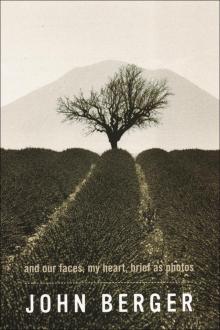 And Our Faces, My Heart, Brief as Photos
And Our Faces, My Heart, Brief as Photos Titian
Titian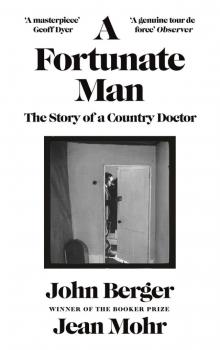 A Fortunate Man
A Fortunate Man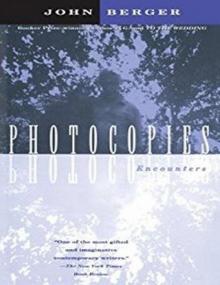 Photocopies: Encounters (Vintage International)
Photocopies: Encounters (Vintage International)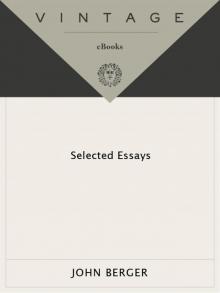 Selected Essays of John Berger
Selected Essays of John Berger